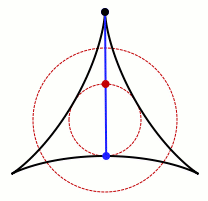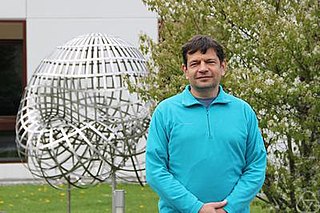
In mathematics, a Kakeya set, or Besicovitch set, is a set of points in Euclidean space which contains a unit line segment in every direction. For instance, a disk of radius 1/2 in the Euclidean plane, or a ball of radius 1/2 in three-dimensional space, forms a Kakeya set. Much of the research in this area has studied the problem of how small such sets can be. Besicovitch showed that there are Besicovitch sets of measure zero.
In arithmetic combinatorics, Szemerédi's theorem is a result concerning arithmetic progressions in subsets of the integers. In 1936, Erdős and Turán conjectured that every set of integers A with positive natural density contains a k-term arithmetic progression for every k. Endre Szemerédi proved the conjecture in 1975.

Jean Louis, baron Bourgain was a Belgian mathematician. He was awarded the Fields Medal in 1994 in recognition of his work on several core topics of mathematical analysis such as the geometry of Banach spaces, harmonic analysis, ergodic theory and nonlinear partial differential equations from mathematical physics.
The Szemerédi–Trotter theorem is a mathematical result in the field of Discrete geometry. It asserts that given n points and m lines in the Euclidean plane, the number of incidences is

Terence Chi-Shen Tao is an Australian mathematician. He is a professor of mathematics at the University of California, Los Angeles (UCLA), where he holds the James and Carol Collins chair. His research includes topics in harmonic analysis, partial differential equations, algebraic combinatorics, arithmetic combinatorics, geometric combinatorics, probability theory, compressed sensing and analytic number theory.

Ben Joseph Green FRS is a British mathematician, specialising in combinatorics and number theory. He is the Waynflete Professor of Pure Mathematics at the University of Oxford.
In mathematics, arithmetic combinatorics is a field in the intersection of number theory, combinatorics, ergodic theory and harmonic analysis.
In discrete geometry, the Erdős distinct distances problem states that every set of points in the plane has a nearly-linear number of distinct distances. It was posed by Paul Erdős in 1946 and almost proven by Larry Guth and Nets Katz in 2015.
Lawrence David Guth is a professor of mathematics at the Massachusetts Institute of Technology.
In arithmetic combinatorics, the Erdős–Szemerédi theorem states that for every finite set of integers, at least one of , the set of pairwise sums or , the set of pairwise products form a significantly larger set. More precisely, the Erdős–Szemerédi theorem states that there exist positive constants c and such that for any non-empty set
In geometric measure theory, Falconer's conjecture, named after Kenneth Falconer, is an unsolved problem concerning the sets of Euclidean distances between points in compact -dimensional spaces. Intuitively, it states that a set of points that is large in its Hausdorff dimension must determine a set of distances that is large in measure. More precisely, if is a compact set of points in -dimensional Euclidean space whose Hausdorff dimension is strictly greater than , then the conjecture states that the set of distances between pairs of points in must have nonzero Lebesgue measure.

In affine geometry, a cap set is a subset of where no three elements sum to the zero vector. The cap set problem is the problem of finding the size of the largest possible cap set, as a function of . The first few cap set sizes are 1, 2, 4, 9, 20, 45, 112, ....
Fuglede's conjecture is an open problem in mathematics proposed by Bent Fuglede in 1974. It states that every domain of is a spectral set if and only if it tiles by translation.

József Solymosi is a Hungarian-Canadian mathematician and a professor of mathematics at the University of British Columbia. His main research interests are arithmetic combinatorics, discrete geometry, graph theory, and combinatorial number theory.
In geometry, the distance set of a collection of points is the set of distances between distinct pairs of points. Thus, it can be seen as the generalization of a difference set, the set of distances in collections of numbers.
Roth's theorem on arithmetic progressions is a result in additive combinatorics concerning the existence of arithmetic progressions in subsets of the natural numbers. It was first proven by Klaus Roth in 1953. Roth's theorem is a special case of Szemerédi's theorem for the case .
In mathematics, the polynomial method is an algebraic approach to combinatorics problems that involves capturing some combinatorial structure using polynomials and proceeding to argue about their algebraic properties. Recently, the polynomial method has led to the development of remarkably simple solutions to several long-standing open problems. The polynomial method encompasses a wide range of specific techniques for using polynomials and ideas from areas such as algebraic geometry to solve combinatorics problems. While a few techniques that follow the framework of the polynomial method, such as Alon's Combinatorial Nullstellensatz, have been known since the 1990s, it was not until around 2010 that a broader framework for the polynomial method has been developed.

The Erdős Distance Problem is a monograph on the Erdős distinct distances problem in discrete geometry: how can one place points into -dimensional Euclidean space so that the pairs of points make the smallest possible distance set? It was written by Julia Garibaldi, Alex Iosevich, and Steven Senger, and published in 2011 by the American Mathematical Society as volume 56 of the Student Mathematical Library. The Basic Library List Committee of the Mathematical Association of America has suggested its inclusion in undergraduate mathematics libraries.

















